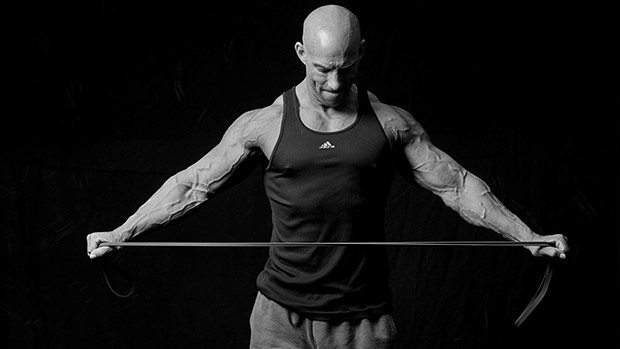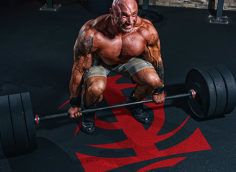People often overlook bodyweight training because they think it's not hard enough. But it's certainly possible to build muscle using your own bodyweight, especially if you can turn it into a challenge.
Below you'll find eight intense methods to maximize muscle growth using basic bodyweight exercises.
As a bonus, a lot of these methods have the side benefit of dramatically improving your mind-muscle connection. Think of them as an investment in future gains. By improving mind-muscle connection, you'll make every future lifting program you do more effective.
This is one of my favorite intensification methods. It helps stimulate growth, but I like it even more as a way to improve the mind-muscle connection.
It's fairly straightforward: You start each set with an isometric hold at a key position in the movement. If you're after muscle growth, use the position where you can feel the most tension in the target muscle:
- Bodyweight Squat: Hold the isometric in the mid-range position for 10-60 seconds, then do as many reps as you can. (See video.)
- Push-Up: Hold the isometric in the mid-range or near the bottom position.
- Pull-Up Variations: Hold the peak contraction position.
Start your set with the isometric hold. The hold should be anywhere between 10 and 30 seconds depending on how strong you are. On bodyweight squats, you could go up to 60 seconds, but most people should try a 10-30 second hold with maximum tension.
In the video Paul is using the 60-second version because he's a pro football player who squats over 500 pounds, but even bodyweight alone crushes him!
Once you're done with your hold, do as many solid reps as you can. And here's the secret, try to feel the same tension as you did during the hold. If you can get more than 12 reps, lengthen the hold, or slow down your reps.
The Hold Position: Make it as demanding as you can! This means creating as much tension as possible.
For instance, if you're holding a position on a push-up or dip, try to "squeeze inward" in an effort to bring your hands closer together, even though they won't move. That intent will greatly increase pectoral contraction.
In a squat, try to "screw your feet into the floor" by attempting to externally rotate them, or "press the floor with the toes" and "tense the abs as if you were going to get punched in the stomach."
In a pull-up, flex your biceps and upper back hard by trying to pull the bar toward you even though it'll likely already be against you.
These actions will not only create more muscle fiber recruitment, they'll also develop your capacity to contract and feel key muscles. That way, when you get back to lifting weights, these muscles will respond a lot better.
Do three holds during your set (same position as for the previous method) then do reps after each hold. For example:
- Hold the bottom position of a push-up for 10 seconds, then do 5 reps.
- Hold the bottom position again for 10 seconds, then do 5 reps.
- Hold the bottom position once more for 10 seconds, then do as many reps as possible.
That's all one set. So don't stop between the reps and the holds.
You can play with the amount of time you spend on the holds. If you can get more than 12 total reps, lengthen the time of the holds.
Now, the holds don't all have to be the same length. You could do 20 seconds on the first one, 15 seconds on the second, and 10 seconds to finish.
I use this method quite a bit with athletes on the big basic lifts, but it can also be very effective for bodyweight movements. You can also design a progression model by varying the type of holds you do.
First, everything I said earlier about maximizing tension in a hold and making it hard still applies... and that goes for every type of hold here.
We can vary the difficulty of a set by changing any of the following parameters:
The number of holds: You can do one to three holds within each rep. It's hard to do more than that because you'll run out of range of motion.
The length of each hold: We normally use three to six seconds per hold. Of course, longer is harder. Normally, the more holds there are in a rep, the shorter they are. Here's a good rule of thumb:
- 1 hold per rep = 5-6 seconds per hold
- 2 holds per rep = 4-5 seconds per hold
- 3 holds per rep = 3-4 seconds per hold
When you do the holds: Doing holds during the concentric (lifting) phase is harder than doing them during the eccentric (lowering) phase. We can build a hierarchy of difficulty for this category, from the easiest to the hardest:
- One hold on the eccentric
- Two holds on the eccentric
- One hold on the concentric
- Three holds on the eccentric
- One hold on the eccentric, one hold on the concentric
- Two holds on the eccentric, one hold on the concentric
- Two holds on the concentric
- One hold on the eccentric, two holds on the concentric
- Three holds on the concentric
So you can progress either by doing more reps per set under the same conditions or by maintaining your number of reps while making the conditions harder. Holds are one way to do that.
To give you an idea of how brutal this one can be, take a look at the video and keep in mind that this is a pro football player who squats over 500... and he's not able to finish the last 30 seconds with bodyweight only!
The next few methods will focus on making a set more difficult by lengthening the duration of the eccentric phase of a movement (or the concentric in some cases). Might as well start with the most excruciating one!
- You start by doing a 30-second long eccentric (lowering) phase, then immediately do 10 normal reps. Still control the eccentric on the normal reps – two seconds down is a good target.
- After your tenth rep, finish with one final 30-second eccentric, after which you may or may not try to stand up (or push/pull yourself up). My guess is that you won't be able to do it.
Is 30-10-30 too easy for you? It might be on bodyweight squats. Just do 15 or 20 reps instead of 10. Or for an even greater challenge, do this with Bulgarian split squats and see how your legs (and pride) feel after that!
Paul, who's demonstrating this exercise, has a do-or-die mentality. I'd recommend stopping 1-2 reps before he did.
- In this method you start with slow eccentric or negative reps. Lower down in 8-10 seconds per rep and go up normally. Do as many reps like that as you can.
- When 10 seconds start to feel like a dinner at the in-laws, you can speed things up and even use some momentum to try to get a few extra reps.
It's pretty straightforward, and if you can endure pain, this will be very effective for you.
I've always loved this method (even with weight training exercises) to maximize growth and improve the mind-muscle connection. It consists of alternating between slow and normal reps.
You start by doing two slow reps, then do two fast reps, two more slow reps, two more fast reps, and so on.
- First Rep: Slow (6 seconds down, 3 seconds up)
- Second Rep: Slow (6 seconds down, 3 seconds up)
- Third Rep: Fast (2 seconds down, 1 second up)
- Fourth Rep: Fast (2 seconds down, 1 second up)
- Fifth Rep: Slow (6 seconds down, 3 seconds up)
- Sixth Rep: Slow (6 seconds down, 3 seconds up)
- Seventh Rep: Fast (2 seconds down, 1 second up)
- Eighth Rep: Fast (2 seconds down, 1 second up)
- And so on...
Ideally, you wouldn't have to do more than twelve total reps. If you can, either change the movement (e.g. Bulgarian split squat instead of bodyweight squat) or add weight (holding a dog or a backpack loaded with books for example).
This will work best for bodyweight exercises where it's hard to get more than 12 solid reps (like chin-ups or handstand push-ups) or for which you can add some weight (bodyweight squat holding a loaded backpack). It's not ideal for exercises where you can pump out 30-plus reps, but I'll give you an alternative in a moment.
- You start by doing the full range of motion for the movement. The "easier" the exercise is for you (i.e. the more reps you can get), the slower the tempo should be. At the most, you should be getting 10-12 full-range reps with the slow tempo.
- When you reach a point close to failure, shorten the range of motion and continue doing partial reps until failure. For these, the partials would be at the top of the range of motion.
If you want to use the method for exercises where you can normally pump out 30-plus reps – like push-ups or bodyweight squats – just start the set with a 30-second hold (like in our first method), then proceed with the regressive ROM set.
Myo reps are essentially a multi rest-pause set.
- First go to failure on an exercise (ideally in 20 reps or fewer, so you might need to add resistance).
- Once you reach failure or close to it, rest around 10 seconds and do three more reps.
- Rest 10 seconds and do three reps.
- Repeat until you either fail to get three reps in a mini-set or reach five mini-sets of three reps.
These methods will make the basic bodyweight movements a lot more demanding and more effective at triggering growth. But don't forget that it's possible to add resistance if you're a little bit creative.
I already mentioned the loaded backpack method, which can be used on squats, split squats, chin-ups, and even push-ups and dips. On squats you can put it on your back or even hold it in front Zercher style, getting a bit more core and arm work in the process.
Any fairly light object that's not too cumbersome can be used to add resistance. Remember: It doesn't matter if you don't know the exact weight of the object you're using, nor that you can't progress in 5-pound increments like in the gym. We're not talking about a lifelong solution here, but a temporary one to help you keep building muscle until you can get back to the gym.

A simple and inexpensive way to improve a home workout is to buy exercise resistance bands. You can go with the looped ones or those with handles.
You can very effectively do curls, tricep pressdowns, lateral raises, front raises, shoulder presses, and straight-arm pulldowns with bands. You can also use them to make push-ups, squats, and split squats harder. They're fairly cheap too.
I see two problems with at-home training using bodyweight exercises. Both are psychological issues.
First, the proximity factor. It actually requires more discipline to train at home than to go to the gym. You're probably thinking, "How could that be if going to the gym is a bigger commitment and more effort?"
Well, that's the exact reason! At home, you can do it any time. It's easy to think, "I'll do it a little later," but in reality most people get to the end of the day not having trained, and now they're too tired to get after it.
The second element is that for most of us, bodyweight training isn't motivating, especially on the simpler exercises. We love lifting weights, seeing the loads increase, and the feeling of heavy resistance on our body. I get it. I'm like that too.
But I learned to appreciate proper bodyweight training when I started doing a lot of international seminars. Traveling on a tight schedule and presenting makes it hard to find a gym and take the time to go train. I started doing hotel bodyweight workouts (as well as using resistance bands) which allowed me to keep muscle mass intact when traveling.
I won't lie to you, it's an acquired taste, but if you want to maintain your gainz, you need to do it!
T Nation earns from qualifying purchases as an Amazon Associate. Read more about our policy.





